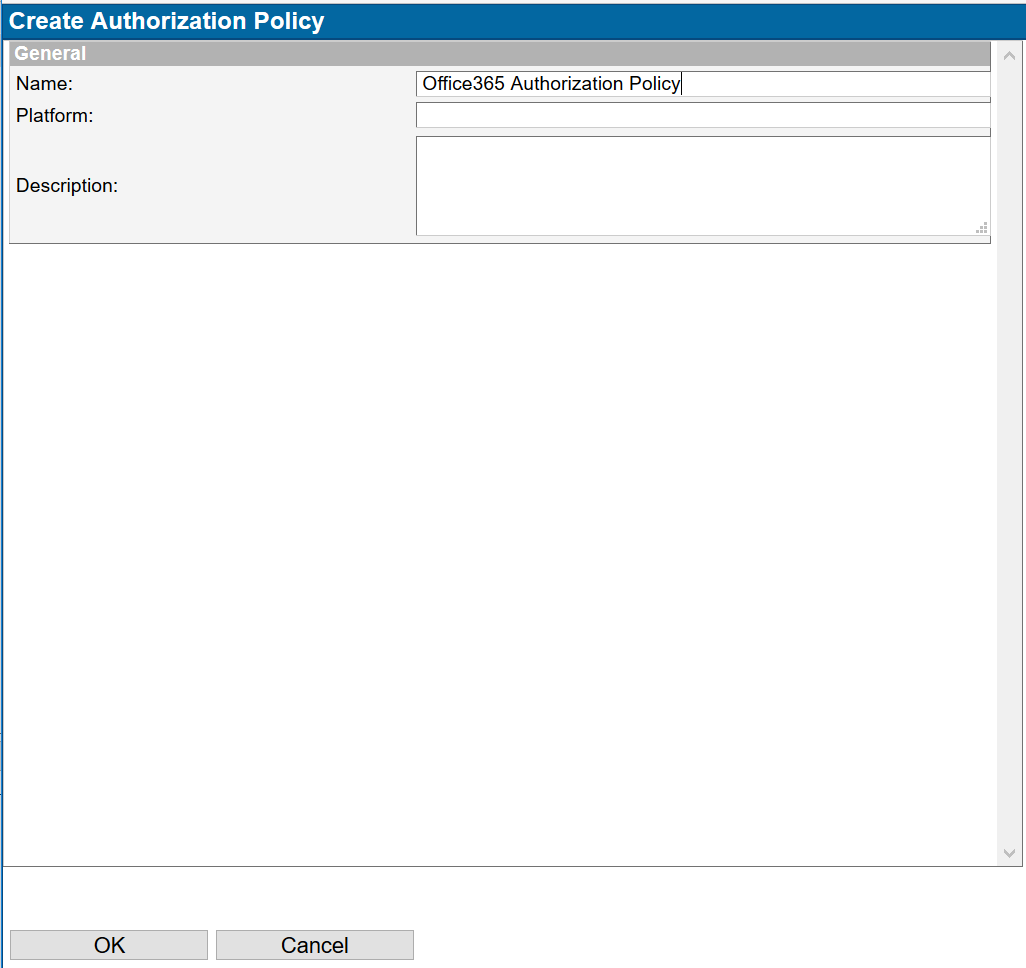To allow users authenticated using Ubisecure SSO to log into Office365 applications, or any Azure AD connected application.
Step-by-step guide
To configure an IDP for Office365, complete the following steps:
- Create an Agent
- SAML Application
- Use compatibility flags:
AuthnRequestValidate AssertionSignCertificate HttpPostResponseSign
- Use compatibility flags:
- SAML Application
- Create a new Authorization Policy
- Create Policy
- Press OK
- Select the Attributes tab, select Add...
- Choose a group, such as eIDMUser group from the eIDM Groups site. This group contains all registered CustomerID users.
- Add the following attributes
${nameID.format('persistent').value('ImmutableID')}${attribute.nameFormat(null).name('IDPEmail').values('Mail')}${issuer.value('Issuer')}
- Attach policy to agent
TODO - Complete the rest of the appropriate settings for access control
- Create Policy
- Activate the agent in Azure AD
- Set Azure AD domain to Federated mode with Ubisecure SSO as IDP
Use the model powershell script to activate using the Azure APIs
Code Block $upn = "admin@ubidemo2.onmicrosoft.com" $file = "$($env:USERPROFILE)\AzureAD\$upn.txt" $credendial = $null if(Test-Path $file) { $credendial = [pscredential]::new($upn, (Get-Content -Path $file | ConvertTo-SecureString)) } else { $dir = Split-Path -Parent -Path $file New-Item -Force -ItemType Directory -Path $dir | Out-Null $credendial = Get-Credential -Message $upn -UserName $upn $file = Join-Path -Path $dir -ChildPath "$($credendial.UserName).txt" ConvertFrom-SecureString -SecureString $credendial.Password | Set-Content -Path $file -Force } Connect-MsolService -Credential $credendial #$sso = "https://sso.ubidemo1.com" $sso = "https://gmo.ubidemo.com" $metadata = Invoke-WebRequest -Uri "$sso/uas/wsf/FederationMetadata.xml" -UseBasicParsing | Select-Object -ExpandProperty Content $cert = ([xml]$metadata).EntityDescriptor.RoleDescriptor.KeyDescriptor.KeyInfo.X509Data.X509Certificate $cert = [Convert]::ToBase64String([System.Security.Cryptography.X509Certificates.X509Certificate]::new([Convert]::FromBase64String($cert)).GetRawCertData()) #$MetadataExchangeUri = "$sso/uas/wsf/FederationMetadata.xml" $MetadataExchangeUri = "$sso/uas" #$MetadataExchangeUri = "urn:null" $IssuerUri = "https://ubidemo2.com" #$IssuerUri = "$sso/uas" if($false) { Remove-MsolUser -UserPrincipalName "koskmaar@ubidemo1.com" -Force:$true Remove-MsolUser -UserPrincipalName "koskmaar@ubidemo1.com" -Force:$true -RemoveFromRecycleBin Remove-MsolDomain -DomainName "ubidemo2.com" -Force:$true New-MsolDomain -Name "ubidemo2.com" -VerificationMethod DnsRecord Get-MsolDomainVerificationDns -DomainName "ubidemo2.com" Confirm-MsolDomain -DomainName "ubidemo2.com" } if($false) { New-MsolUser -UserPrincipalName "koskmaar@ubidemo1.com" -DisplayName "Maarit Koskinen" -ImmutableId "6HNhl3wbx0GSrkC96VWQ0g==" -FirstName "Maarit" -LastName "Koskinen" } if($false) { Set-MsolDomainAuthentication -Authentication Managed -DomainName "ubidemo2.com" } if($false) { Set-MsolDomainAuthentication ` -Authentication Federated ` -DomainName "ubidemo2.com" ` -ActiveLogOnUri "$sso/uas/saml2/soap/SingleSignOnService" ` -FederationBrandName "ubidemo2.com" ` -IssuerUri $IssuerUri ` -LogOffUri "$sso/uas/logout" ` -MetadataExchangeUri $MetadataExchangeUri ` -NextSigningCertificate $null ` -OpenIdConnectDiscoveryEndpoint $null ` -PassiveLogOnUri "$sso/uas/saml2/SingleSignOnService" ` -PreferredAuthenticationProtocol Samlp ` -SigningCertificate $cert ` -Verbose Set-MsolDomainFederationSettings ` -DomainName "ubidemo2.com" ` -ActiveLogOnUri "$sso/uas/saml2/soap/SingleSignOnService" ` -FederationBrandName "ubidemo2.com" ` -IssuerUri $IssuerUri ` -LogOffUri "$sso/uas/logout" ` -MetadataExchangeUri $MetadataExchangeUri ` -NextSigningCertificate $null ` -OpenIdConnectDiscoveryEndpoint $null ` -PassiveLogOnUri "$sso/uas/saml2/SingleSignOnService" ` -PreferredAuthenticationProtocol Samlp ` -SigningCertificate $cert ` -Verbose } Set-MsolDomainFederationSettings ` -DomainName "ubidemo2.com" ` -ActiveLogOnUri "$sso/uas/saml2/soap/SingleSignOnService" ` -FederationBrandName "ubidemo2.com" ` -IssuerUri $IssuerUri ` -LogOffUri "$sso/uas/logout" ` -NextSigningCertificate $null ` -PassiveLogOnUri "$sso/uas/saml2/SingleSignOnService" ` -PreferredAuthenticationProtocol Samlp ` -SigningCertificate $cert ` -Verbose Get-MsolDomainFederationSettings -DomainName "ubidemo2.com" | fl
- remove certificates from metadata when activating
- Set Azure AD domain to Federated mode with Ubisecure SSO as IDP
...
| Info |
|---|
| This enables sign-in using Modern Authentication, supported by modern Office fat client applications. Legacy clients using WS-Federation Active Profile are not supported. |
Related articles
| Filter by label (Content by label) | ||||||||||||||||||
|---|---|---|---|---|---|---|---|---|---|---|---|---|---|---|---|---|---|---|
|
...



